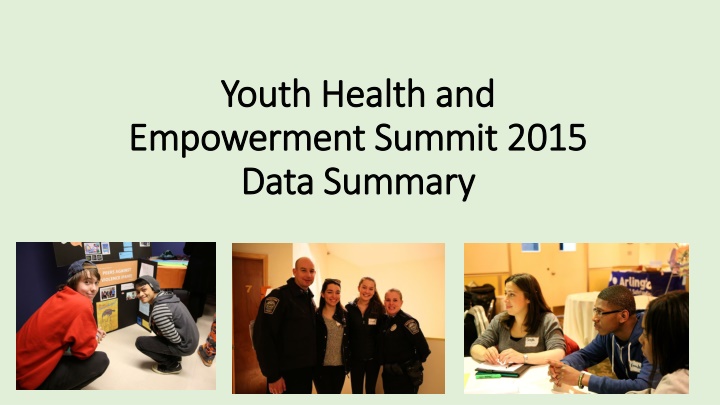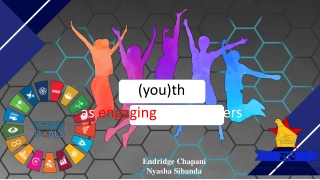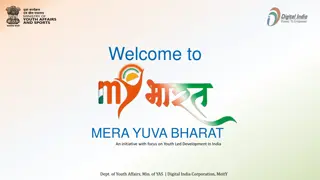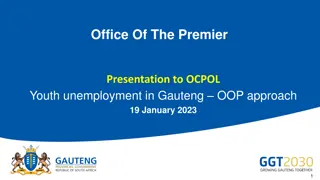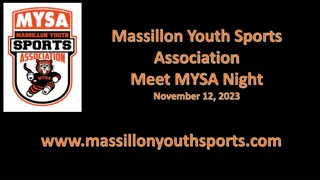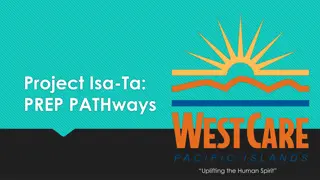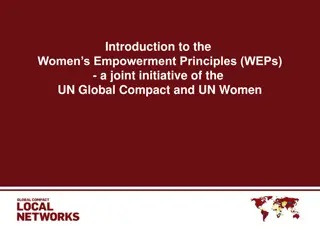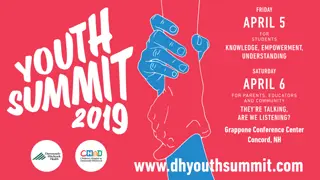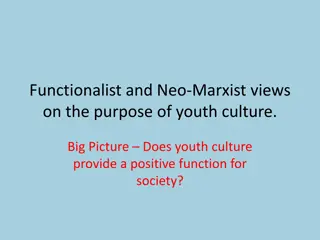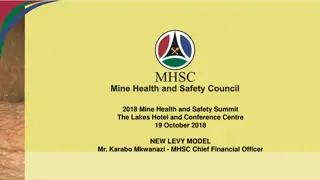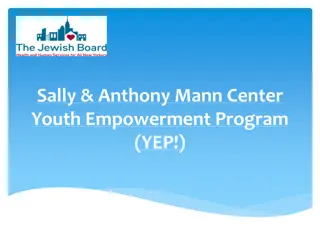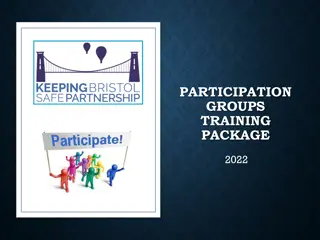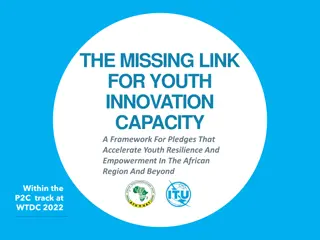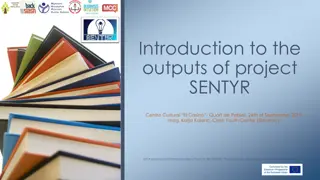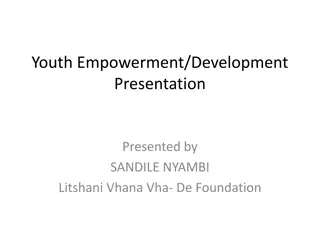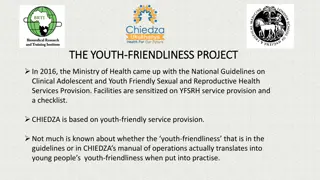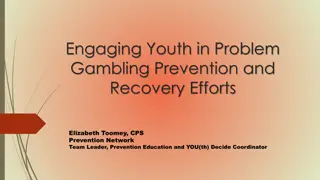Youth Health and Empowerment Summit Data Summary 2015 Data Summary
This summary captures the data from the 2015 Youth Health and Youth Health and Empowerment Summit. It provides valuable insights and key takeaways from the summit, focusing on youth health and empowerment issues discussed during the event. The data summary offers a comprehensive overview of the topics covered, highlighting the importance of youth empowerment and well-being. Stay informed with this concise summary of the summit's data and discussions.
Download Presentation

Please find below an Image/Link to download the presentation.
The content on the website is provided AS IS for your information and personal use only. It may not be sold, licensed, or shared on other websites without obtaining consent from the author.If you encounter any issues during the download, it is possible that the publisher has removed the file from their server.
You are allowed to download the files provided on this website for personal or commercial use, subject to the condition that they are used lawfully. All files are the property of their respective owners.
The content on the website is provided AS IS for your information and personal use only. It may not be sold, licensed, or shared on other websites without obtaining consent from the author.
E N D
Presentation Transcript
Youth Health and Youth Health and Empowerment Empowerment Summit Data Summary Data Summary Summit 2015 2015
Registration Statistics Which do you think is the greatest health-related issue that impacts youth today in your community? Selected during Pre-Registration* Number Pre-Registered: 212 Number attended: 162 Attendees by City 16.2% Multi-City 6% Watertown 4% Youth Attendees: 96 Adult Attendees: 66 28.4% 13.5% Waltham 8% 13.5% Grantees: 93 Non-grantees: 69 Cambridge 33% 18.9% 10.8% 20.3% Somerville 36% 59.5% Arlington 12% 20.3% 8.1% *Note: Most pre-registrations were completed by adult staff for youth.
Pre-Survey Open-Ended Questions Notes: 152 respondents in the pre-survey 114 respondents in the post-survey 1 missing respondent from Questions 1-5 in the post-survey (in the 18 and under category). 48 respondents with age unknown in the pre-survey 14 respondents with age unknown in the post survey. Age unknown responses are included in the group summaries, but not in the age breakdowns. There was a positive change on every question when comparing pre-test and post-test results.
Q1 Q1: : I am aware of the community health issues that affect youth in I am aware of the community health issues that affect youth in Cambridge, Somerville, Cambridge, Somerville, Arlington, Waltham Arlington, Waltham, Watertown, and Question 1: All Respondents , Watertown, and Belmont Belmont 18.4% Strongly Agree 37.2% 92% agreed after the conference, 24% more than pre-survey. 48.7% Agree 54.9% Biggest change for 19- 24 year olds (29%) 23.7% Neither Agree nor Disagree 7.1% The pre-survey average was 3.7 and post survey average was 4.27 3.3% Disagree 0.0% 5.9% Strongly Disagree 0.9% 0.0% 10.0% 20.0% 30.0% 40.0% 50.0% 60.0% 70.0% Pre Post
Q2 Q2: : I understand different ways to prevent and address community health I understand different ways to prevent and address community health issues that affect issues that affect youth youth Question 2: All Respondents 19.1% Strongly Agree 85% agreed after the conference, 21% more than pre-survey. 31.0% 45.4% Agree 54.0% Biggest change for 25+ year olds (29%) 25.0% Neither Agree nor Disagree 12.4% The pre-survey average was 3.68 and post survey average was 4.11 6.6% Disagree 0.9% 3.9% Strongly Disagree 1.8% 0.0% 10.0% 20.0% 30.0% 40.0% 50.0% 60.0% 70.0% Pre Post
Q3 Q3: : I know many different local youth and adults who are dedicated to I know many different local youth and adults who are dedicated to addressing and preventing community health issues that affect addressing and preventing community health issues that affect youth youth Question 3: All Respondents 27.6% Strongly Agree 41.6% 84% agreed after the conference, 20% more than pre-survey. 36.9% Agree 42.5% Biggest change for 25+ year olds (22%) 22.4% Neither Agree nor Disagree 15.0% The pre-survey average was 3.68 and post survey average was 4.11 9.2% Disagree 0.0% 3.9% Strongly Disagree 0.9% 0.0% 10.0% 20.0% 30.0% 40.0% 50.0% 60.0% 70.0% Pre Post
Q4 Q4: : I am aware of many different local resources and I am aware of many different local resources and organizations that support youth who face health issues and organizations that support youth who face health issues and prevent the issues from happening in the first prevent the issues from happening in the first place place Question 4: All Respondents 20.4% 83% agreed after the conference, 20% more than pre-survey. Strongly Agree 34.5% 42.8% Agree 48.7% Biggest change for 19- 24 year olds (36%) 26.3% Neither Agree nor Disagree 15.0% The pre-survey average was 3.69 and post survey average was 4.14 6.6% Disagree 0.9% 3.9% Strongly Disagree 0.9% 0.0% 10.0% 20.0% 30.0% 40.0% 50.0% 60.0% 70.0% Pre Post
Q5 Q5: : I have the knowledge, confidence, and resources to manage I have the knowledge, confidence, and resources to manage my my stress stress Question 5: All Respondents 20.4% Strongly Agree 88% agreed after the conference, 21% more than pre-survey. 38.1% 46.7% Agree 49.6% Biggest change for 25+ year olds (26%) 21.7% Neither Agree nor Disagree 8.8% The pre-survey average was 3.89 and post survey average was 4.21 3.3% Disagree 0.0% 2.6% Strongly Disagree 0.9% 0.0% 10.0% 20.0% 30.0% 40.0% 50.0% 60.0% 70.0% Pre Post
Post-Survey Open-Ended Questions Notes: Out of the 114 respondents on the post-survey 89 respondents answered the first open-ended question, 79 respondents answered the second question, 95 respondents answered the third question, and 72 respondents answered the last question.
Q1: Please write at least one point from today's Youth, Health and Empowerment Summit that stands out for you as important. 10% 13% 7% 36% 26% 8% Trauma/Mental Health Awareness and Understanding Drug/Alcohol Awareness and Understanding General Awareness and Understanding of Youth Health Issues Entertainment - Speakers Awareness of Solutions and Community Action - Empowerment Other
Q1: Please write at least one point from today's Youth, Health and Empowerment Summit that stands out for you as important. It gives people the chance to spread their ideas (age 13) It is important to have a safe environment (age 15) There are many problems that our youth face but there are also solutions (age 16) Having a place to discuss these issues is very reassuring (age 17) People can empower each other through organizing, esp. young people (age 22) It's time for us as youth to take a stand and bring the conversation from our perspective (age 23) There are a lot of motivated, invested youth whose voices we should listen to more often! (age 36)
Q2: How can we improve the Summit? 15% 20% 14% 19% 9% 19% 4% More movement and interaction with others - More activities Make the summit more interesting - More food and/or entertainment - Better food and/or entertainment Increase length - Improve time management - Hold more summits More discussion of solutions/resources Have more teens and/or more people - Improve outreach Would make no improvements Other - Don't Know
Q2: How can we improve the Summit? We can improve it by helping others (age 15) Make sure that the songs and the other aspects pertain to the themes of discussion (age 16) Give time to move between different conversation tables instead of just one (age 17) Capitalize on energy at start of evening (too much sitting). (age 36) Have more of them. Teens need a revenue to talk about issues they face (age 22)
Q3: What did you like best about the Summit? 8% 12% 10% 18% 6% 21% 25% Food Performances - Speakers Networking - Ability to Move - Resources Discussion - Freedom to Speak Mind - Learning from Others Level of Youth Involvement Community - People - Positive Atmosphere Other
Q3: What did you like best about the Summit? The positive attitude and the emotional awareness of the participants (age 16) Small group conversations and share-backs (age 24) I enjoyed hearing young people speak about local issues and ways to face them, especially during the share-back at the end (age 27) Loved the time to see other programs- more time for that (age 31) Opportunity to meet some amazing youth (age 46) I liked that I had a voice. (age 14)
Q4: What next steps can the CHNA take to continue to support youth, adults, and organizations dedicated to addressing youth health and leadership? 13% 12% 22% 43% 10% Continue summits/work CHNA is already doing More outreach/awareness Take action More resources/programs Other/Don't Know
Q4: What next steps can the CHNA take to continue to support youth, adults, and organizations dedicated to addressing youth health and leadership? Keep having events like this, make it more known (age 15) Encourage everyone to share their stories and their ideas (age 16) Involve local people and parents so that they know the health issues youth are going through in the community (age 16) Keep having youth events, keep pushing youth to strive for success (age 16) Use what was said in the summit to better our way to spread the knowledge of problems we face (age 20) Use social media as source for youth to discuss their problems in a welcoming environment (age 23) Create events/opportunities to share resources with youth, adults, and organizations. (age 46).
Mental Health/Depression Unique solutions: Create safe spaces Schools Youth groups, centers Living Spaces Music and art (comedy, theater, drawing, etc.) Forums to talk with others Talking with new people in structured ways (i.e. this event) Community-wide dialogues Social/Mental/Emotional health and wellness support On a college, high school, and even earlier level Transitional Support Helping de-stress in transitions of life Mental Health Social Norms Think substance abuse social norms Raise awareness that many people go through the same thing Make it easier to share Acknowledge what our friends/family are going through
Dating/Relationship Violence Unique solutions: Urge schools to discuss dating violence Teach children early Being a support system/spending time with them Hotlines/non-profit services REACH Beyond Domestic Violence Talk about how abuse can happen in any kind of relationship Reaching out to men and boys
Alcohol/Drug Abuse Unique solutions: Destigmatize support; eliminate negative connotations Utilize media; recognize how to use it effectively Education: people should know available resources Resource guide/advertisements/self publication through media
Youth Homelessness Unique solutions: Every table needs own community We can be our own resources, we just need to find a way to connect More programs and resources Youth ambassadors surveyed teens with housing security issues Broaden definition of homelessness More spaces to talk about all of these problems
Access & Gaps in Youth Activities & Resources Unique solutions: Accessibility More frequent meetings with school counselors before problems to form relationships CRLS has a teen health center for kids to get help, birth control, etc. Somerville has Teen Connection Confidentiality is KEY Need safe center at schools to share these resources
Sexual/Reproductive Health Issues Unique solutions: Offer condoms and birth control Teaching sex ed earlier (9th grade?) Benefits of birth control (Eliminate the stigma) Respect is important, consent, self-esteem Make sure counselors are there for the youth Destigmatize- make these discussions normal Different cultures and their different opinions
Money/Jobs Unique solutions: Create more entrepreneur jobs Connections More advertisements Narrowing wealth gaps Pay youth more Pay interns More internship opportunities Workshops Support from people in the field Things youth are interested in Less discrimination because of age More programming gear Money skills Funding for college
